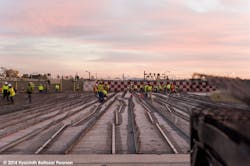Earth Day has come and gone once more, but green is here to stay.
This is the year for Runway Safety Areas (RSAs). By the end of 2015, the FAA has set a goal to improve these features at all commercial service airports. All must comply with the RSA standards which state that a paved or grass 1,000-foot setback or instead, an arrestor bed, must be in place to stop overrun airplanes.
The FAA has been researching this issue since the 1990s and with a group effort of private and public sectors, developed the Engineered Material Arresting System (EMAS). It uses crushable material at the end of the runway to stop airplanes in their tracks at 80 mph. Today, there are two approved EMAS systems and one of them brings "green" to RSAs.
Midway makes its move
A total of 51 airports have arrestor beds in places where RSAs are not possible because of space constraints. The FAA says that since 1999, nine planes have been stopped with EMAS systems. “Airports have the problem of encroaching civilization around them,” says Kirk Marchand, CEO of Runway Safe LLC in Austin, Texas. “You build an airport, some runways and before you know it, there are industrial parks all around and no space to expand. These arrestor systems have helped.”
Recently installed at Chicago Midway International Airport’s Runway 22L, Runway Safe’s product is the first placement of its kind in the country.
Until the Runway Safe solution was approved in 2012, one other EMAS had been accepted for use by the FAA. The green Runway Safe EMAS at Midway replaces the original system by Engineered Arresting Systems Corp. (ESCO), which was installed after a plane went through an airport fence on a snowy Dec. 8, 2005. The Southwest Airlines’ Boeing 737 hit a car and killed a young boy in the vehicle. The incident was a coincidence, as the beds had been approved three months prior by the FAA, but it was led the airport and others to this 2015 requirement.
The ESCO crushable concrete arrestor beds made of lightweight blocks have deteriorated over time, explains Marchand. Jet blast loads have contributed to this. “Especially at an airport like Midway, the pilots use up just about every foot of the runway that they can,” he adds. “They put full thrust to take off and that jet blast blows over the arrestor beds.”
At Midway, this had become a problem that needed addressing, and with the Runway Safe solution now an approved option, the next step was logical.
Installation
Marchand says the arrestor bed installed at MDW is 245 feet long and 170 feet wide, a good option for their limited space and inability to have a full RSA at 1,000 feet long, or the traditional arrestor bed of 600 feet long. “Midway is a unique situation in that the beds were built to fit whatever safety area they had,” he notes, and says the solution for each airport is dependent on its fleet mix, or plane varieties which utilize the pavement.
At Midway, the aircraft coming through are primarily Southwest Airlines’ Boeing 737s. “At O’Hare, it’s a different story,” Marchand says, giving a nod to the larger aircraft for international and cargo flights. “So those arrestor beds will be designed differently.” Currently, Runway Safe has a bid to add additional arrestor beds at Midway and O’Hare International Airport.
The installation at Midway was completed on November 13, 2014, and took three phases to accomplish. First, there were three nights of pre-closure to the runway for removal of the old arrestor bed, surveying the site and installation of anchors.
Second, a total closure of the runway for only 56 hours straight allowed for installation through the CLSM. Marchand says the team began on a Wednesday night, removed the old system. On Saturday it was open for landings and by Monday it was open for departures.
A green EMAS
Runway Safe’s green EMAS system is compliant with the United States FAA Advisory Circular 150/5220-22A. It has three main levels to its composition: (1) a recycled energy-absorbing loose fill material known as foam glass, (2) a protective cover layer comprised of a pour-in-place cement cover slab with a bridge deck top coat, and (3) a sub-structure for anchoring the bed to the underlying pavement, says Marchand.
The Glasopor silica glass foam is the bulk of the material, explains Marchand. It’s a loose fill and every piece is crushable foamed glass. Typically, it can be found as a roadbase material, insulation and on athletic fields.
“It’s a completely stable (chemically and biologically inert) material,” he says. “It’s basically sand, so water or heat won’t break it down.”
The low-strength Glasopor is poured between Tensar BX Geogrid walls then leveled and compacted. The walls provide anchoring against jet blast uplift. The foam glass layer increases in thickness from the front to the back of the arrestor bed, to help a plane smoothly decelerate.
Once the aircraft enters the bed, the landing gear enters and crushes that material. Marchand says it uses up energy, which then slows the aircraft down quicker. The combination of the braking, reverse thrust and now crushing the material allows it to safely stop in a third or half of the normal distance.
He says another benefit of the green EMAS is the absence of chemicals that can leach out, and that it will have a long life and not impact the environment in a negative manner.
Marchand says this system is constructed on-site, not shipped in packages and only assembled at the airport. “We feel it will perform as well or better from a serviceability standpoint,” he says, explains it’s a monolithic system. “There are no joints to leak or weaken over time.”
When it comes to maintenance, this green EMAS comes with a five-year warranty, so while Marchand acknowledges any additional cost is a concern for any airport executive, “life cycle costs will be much lower than with a different system,” he says. “Be assured that for five years you won’t pay a nickel to maintain the bed. Now, if a plane runs into it, that’s another story.”
Taking notes
With Midway being the first U.S. installation of Runway Safe’s green EMAS, Marchand says the company is taking notes. “We truly believe that it’s a system that can be advanced technologically,” he says. “We didn’t produce a system we feel is just good enough.”
He says to tune the EMAS for specific airport needs, pressure sensors are installed at the Midway arrestor bed. They are fitted with pressure gauges and accelerometers to monitor the jet blast loads and structural performance of the product. Marchand explains the company wants to learn as much as it can from the installations so the next generation can be an even better RSA solution. The four seasons of weather at Midway also will be very telling for the future of the system, and Marchand says so far, so good, especially through the first Midwest winter.
While Chicago is not green in March, passengers flying through Midway International Airport can rest assured they are safe and sound, as if lying on a bed of grass on a spring day.
“Airports have the problem of encroaching civilization around them.”
Kirk Marchand, CEO, Runway Safe LLC
“ … at an airport like Midway, the pilots use up just about every foot of the runway that they can.”
Kirk Marchand, CEO, Runway Safe LLC
Sidebar: RSA Recommendations
Sixty-seven percent of the 1,000 Runway Safety Areas (RSAs) in need of updating at commercial service airports across the nation have already been improved and meet FAA standards. But that means 33 percent do not meet this standard, and the deadline to do so is fast approaching, The FAA requires commercial service airports to improve these features by year’s end.
The FAA says many of the Engineered Material Arresting System (EMAS) arrestor beds installed prior to 2006 need re-painting to maintain the integrity and function of the bed. ESCO has developed a plastic seal coating for these beds. But another option, available since 2014, to bring these areas up to FAA standards is the green EMAS from Runway Safe.
About the Author

Jen Bradley
Jen Bradley, owner of Bradley Bylines, is an aviation writer based in East Troy, WI. She may be reached via her website at www.bradleybylines.com.
